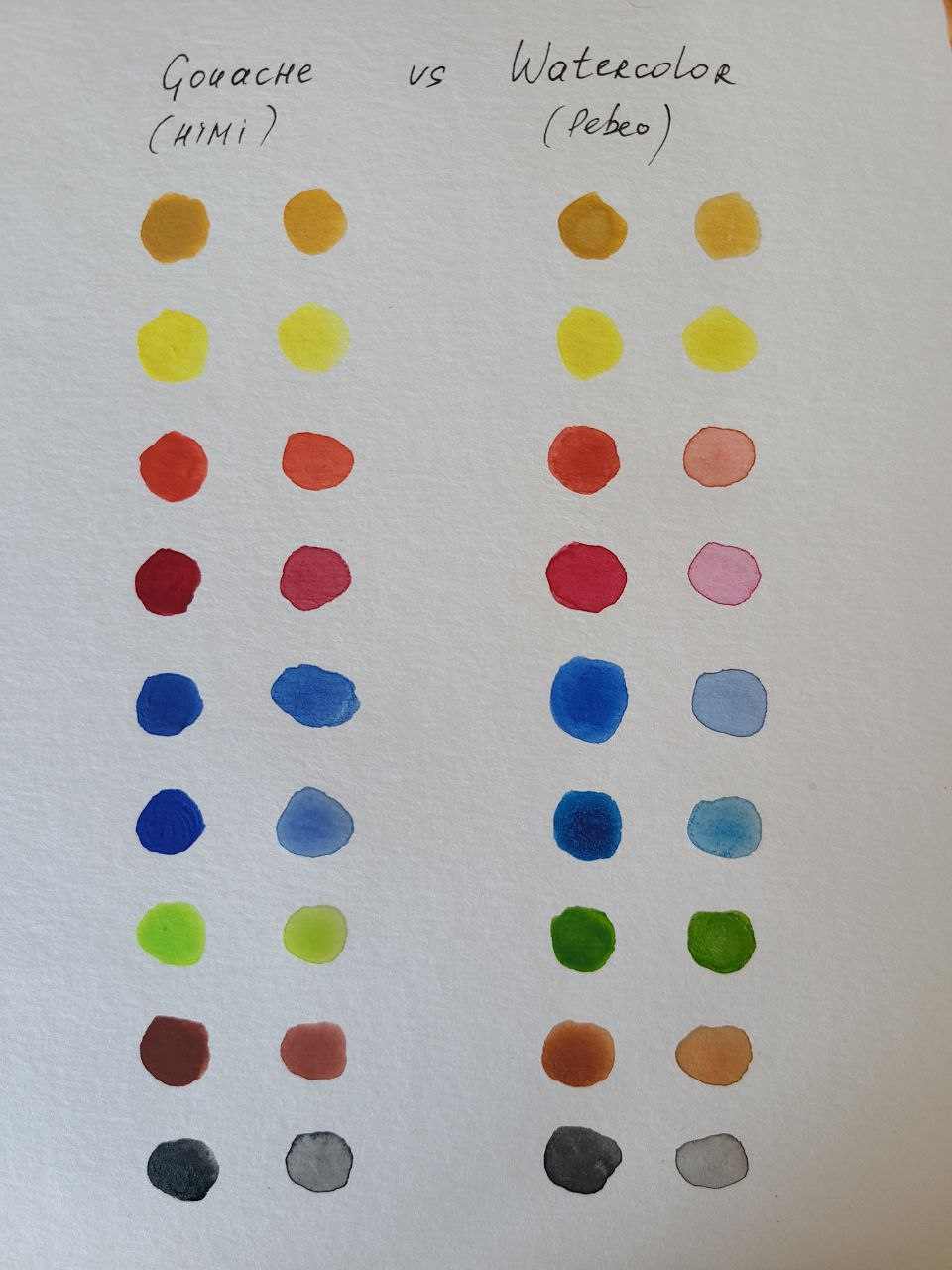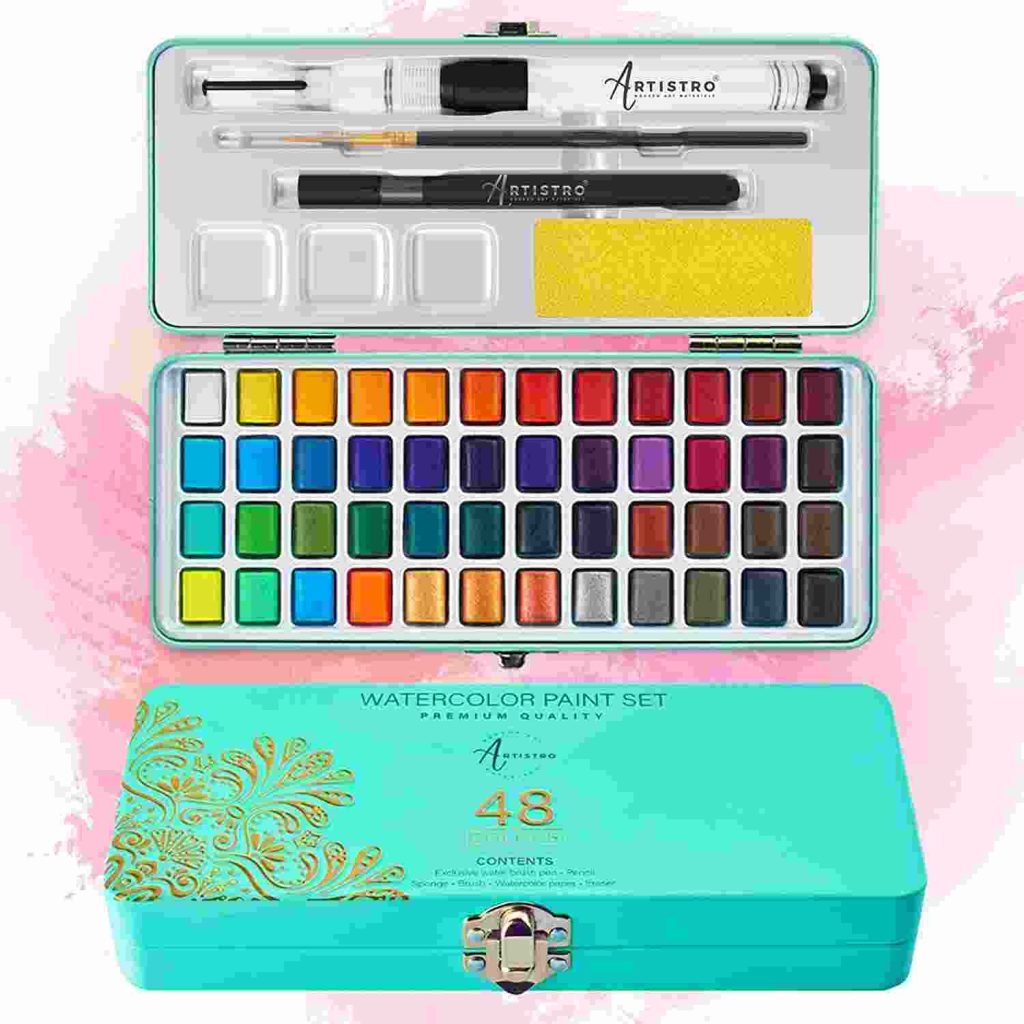Last Updated on November 19, 2023 by Masha Eretnova
You’ve probably wondered about the difference between gouache vs watercolor. Some of you might even ask, “Do they differ, though? Then why can you use watercolor brushes and papers on gouache?”
Well, that’s a valid question, and I totally understand your confusion. They may appear nearly identical, but each has its distinct qualities.
The most noticeable distinction between the two mediums is that gouache gives a more opaque and matte finish than watercolor. Watercolor is transparent, whereas gouache is not. Since watercolor is transparent, the grain of the paper will show through the paint, unlike in gouache, where the paper will not be visible.
If you’d want to understand more about the distinctions between the two, or if you have any questions related to the topic, keep reading, as we will address them in each section of this article.
Table of Contents
Is gouache or watercolor better?
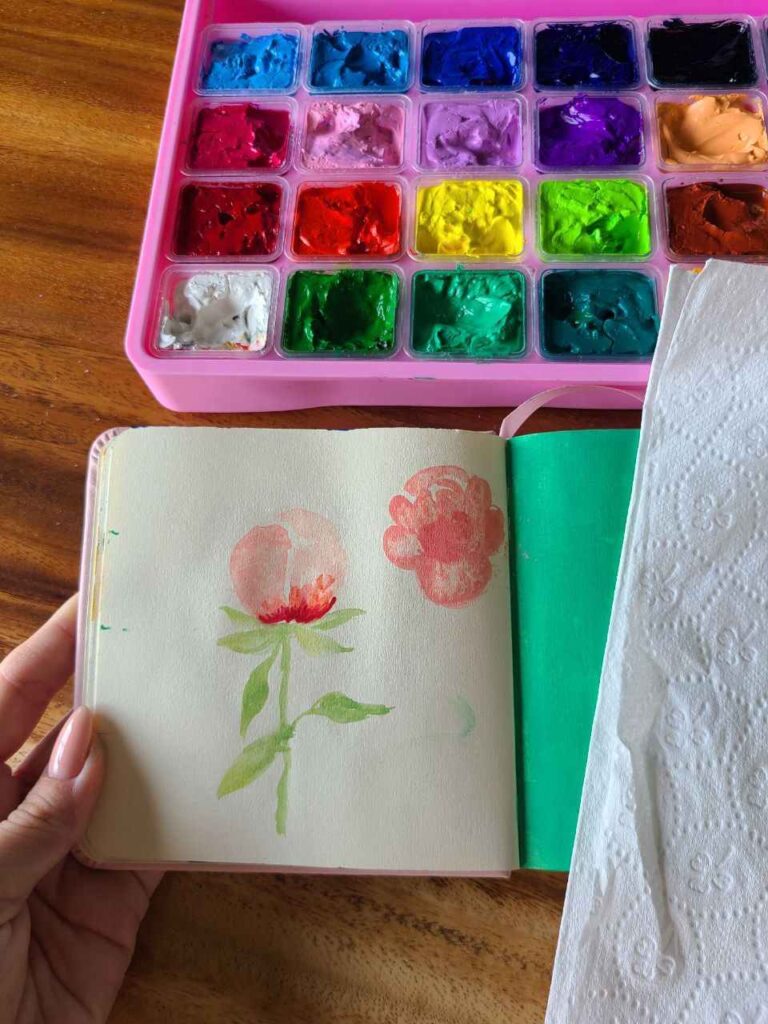
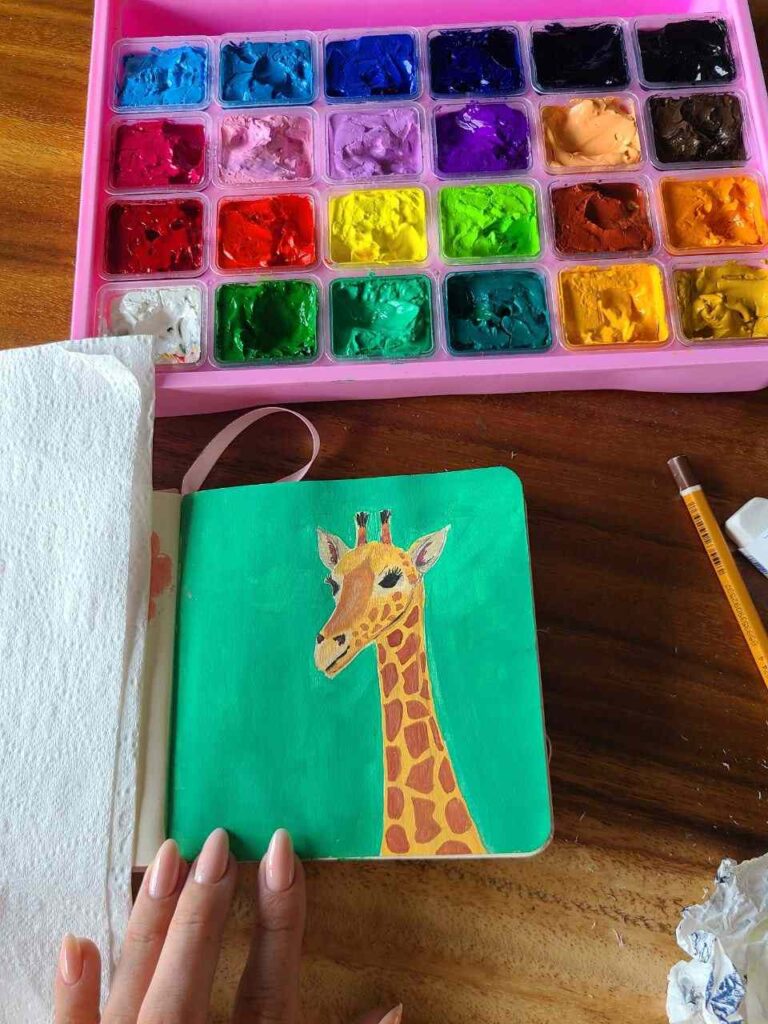
If you’re new to painting, gouache paint and watercolor are both excellent mediums to start with. You might be more familiar with watercolor, but just like this paint, you can also rework your painting with gouache. So, if you would ask which one is better, I would say it depends on whether you prefer a transparent or a matte finish.
In my observation, gouache paint dries faster and is ideally suited for painting bold, flat, vivid shapes. You can use it as a single-layer paint for painting bold objects or as the first layer of a multi-layer painting. If you want an excellent matte finish, go for gouache paints.
On the other hand, watercolors are great for painting several layers because they are not as opaque as gouache. If you’re into a transparent, satin sheen finish, then watercolor is the one for you.
For me, gouache is easier than watercolor as with watercolor you need to learn how to work with water and keep in mind if the colors dry darker, how to layer them and avoid messy colors.
What is the difference between watercolor paint and gouache?
Watercolor and gouache might somehow seem similar, but the two have varying properties. Listed in this table are a few of their primary differences.
You can see their more distinct characteristics, as well as the advantages and disadvantages, in the sections that follow.
A quick note on water-based mediums that gouache, tempera, acrylic, and watercolor are. You always have 3 elements: binder, pigment, and filler.
The binder is what is the difference between acrylic, watercolor, or gouache:
- for acrylics binder is a polymer and plastic and it makes acrylic paint shiny and glossy when it dries.
- for watercolor pigment is thinner and the binder is gum Arabic to achieve transparency.
- for gouache, white chalk is often used as filler to give opacity and gum Arabic as a binder. So gouache is closer to watercolor in terms of the paint composition.
| Criteria | Gouache Paint | Watercolor Paint |
| Finish | Gouache paint provides a bold, flat, matte finish. | Watercolor paint provides a more transparent finish. |
| Users | Many illustrators commonly use gouache paint. | Watercolor paint is widely used by beginners and other types of artists. |
| Dry Colors | Gouache paint dries lighter after application. | Watercolor paint dries neutral after application. |
| Drying Time | Gouache paint dries faster than watercolor. | Watercolor paint dries less quickly than gouache paint. |
| Surfaces | Gouache paint works well for paintings on paper and canvas or illustration boards | Watercolor paint dries neutrally after application. |
| Application | Gouache paint is ideal for creating large, bold areas of color. But among techniques, it can also imitate watercolor. | The watercolor paper mostly. Rarer canvas. |
| Pigment | Gouache paint has larger particles of pigment. | Watercolor paint has smaller particles of pigment and less pigment in general |
| Fillers | Gouache paint may have a filler like chalk to reduce transparency. | Watercolor paint doesn’t need filler as it needs to be transparent. |
Gouache Paint
Gouache paint is a water-based paint that is comparable to watercolor in appearance. Some people refer to gouache as “opaque watercolor.” However, unlike watercolors, gouache is thicker and gives a bold, matte surface when dry.
Illustrators often use gouache because of its opacity. These flat areas of color are simpler to photograph and scan in to make digital graphics.
There is less room for light to pass through due to the closer packing of its large particles. Thus, producing an opaque finish.
Pros
- It is easier to layer shapes on top of each other because of its opaque finish.
- You have more paper options. You can paint it on a sketchbook or mixed media paper. It’s also possible to paint it on colored paper since it is opaque.
- You can paint light on dark.
- It is water-based and easy to clean up.
- It’s easy to carry a palette.
- Gouache paint can be reactivated and manipulated.
- This paint allows for corrections and changes.
- It hides or corrects mistakes better than watercolor.
Cons
- Gouache is less blendable than watercolor.
- Gouache colors don’t simply bleed when they touch.
- Gouache paints can crack once they are dried if applied too thick.
- It is somehow challenging to make it as transparent as watercolor since they provide an opaque, dense finish.
Read also: 23 Top Gouache Painting Tips & Secrets From Pros
Watercolor Paint
Compared to gouache, watercolor dries much more slowly and is much more difficult to control.
Watercolor is more widely known since artists frequently employ it to create landscapes.
When used in a mixed-media composition, it blends beautifully with other media, including graphite, ink, and colored pencils.
In addition, unlike gouache, watercolor pigments contain tiny particles that are not tightly packed.
This makes the paper’s grain visible since light may pass through their paintings, strike the white paper, and then bounce back to the viewer’s eye.
Pros
- Watercolor paints are incredibly easy to blend.
- They are heavily water-based; that’s why they simply bleed when they touch.
- It becomes transparent when mixed with water.
- After application, the watercolor provides a light, bright, transparent finish that can make your painting look shiny.
- It’s excellent for building multiple layers and watery textures.
- It is popular for its fluid washes.
Cons
- Watercolor can cause unintentional blending of colors, which may ruin your painting.
- You need thicker paper, or else your artwork will buckle. Watercolor requires a lot of water; that’s why choosing a watercolor paper is essential for better results.
- You need to carefully control your brush as well as the thickness of the liquid when working with watercolor.
- Watercolor paints can lighten when exposed to the sun and other external elements.
- It is time-consuming to paint with watercolors since you must let each layer dry before applying the subsequent layer.
Gouache vs Watercolor Color shift
Some paints like acrylic or gouache tend to dry darker while watercolor is almost the only one that can dry to a lighter look.
Wet gouache and watercolor:
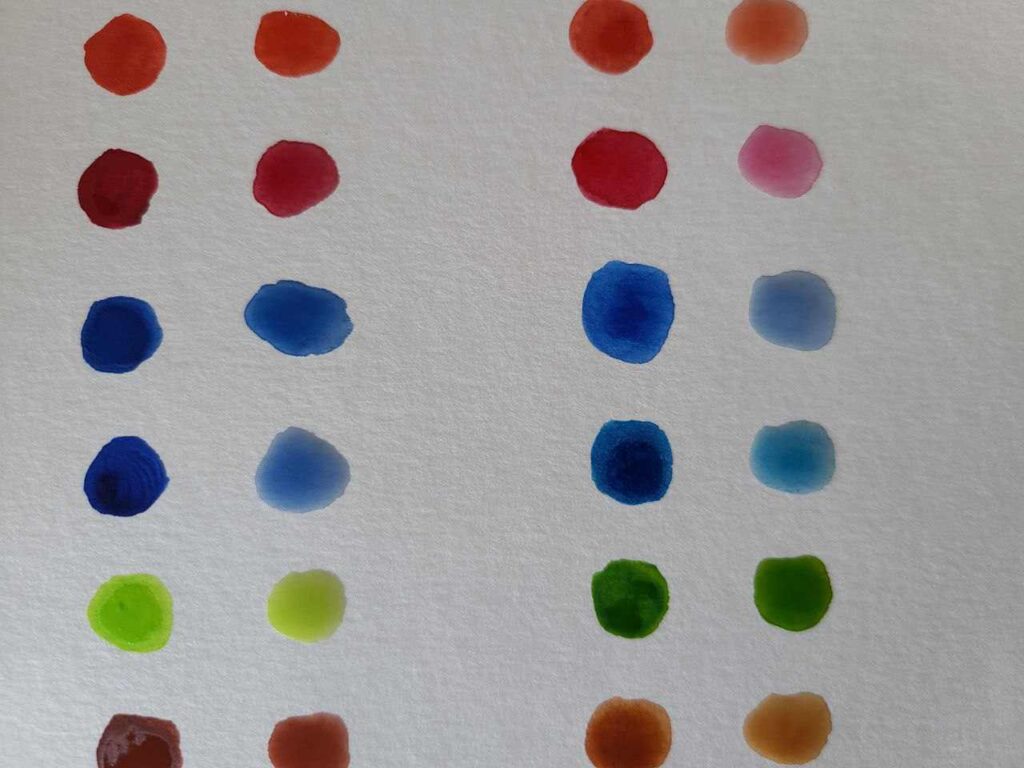
Dry gouache vs watercolor

Gouache vs Watercolor Opacity and Transparency
As we mostly use watercolor diluted with water, it is generally transparent paint.
Even though directly from the tube it comes out pretty opaque we rarely use it without watering it down.
The opposite happens to gouache – we can use it without thinning it too much and it will be more opaque.
The use of water changes the opacity of watercolors a lot, see the right Pebeo watercolor opacity swatch:
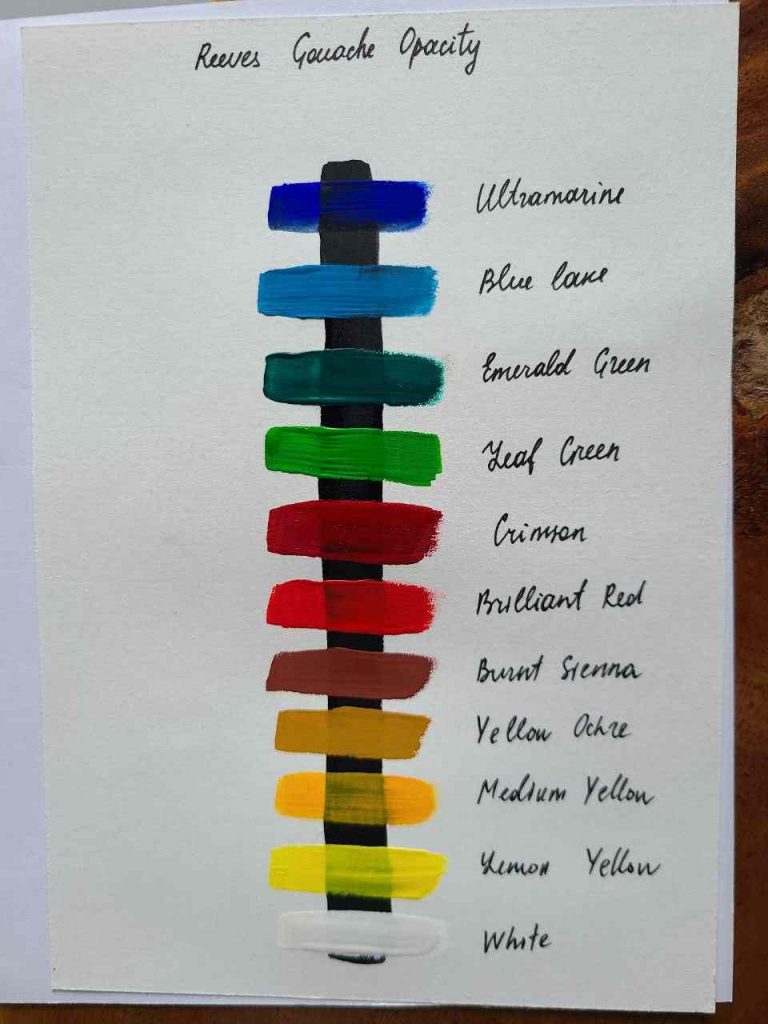

Can gouache be used like watercolor?
Gouache can be used as a watercolor.
Like watercolor, you can rewet gouache with water to make some changes or blend. You can use gouache on papers specially designed for watercolors.
Not only that but watercolor brushes are recommended for use with gouache. Gouache, like watercolor, is water soluble too, which means it can be readily washed off with water.

On the other hand, there are certain limitations regarding how you would use gouache as watercolor. You can’t exactly use gouache in the same way that you would use watercolor paint.
For instance, if you want a lighter color using watercolor, add additional water.
Whereas, if you want to make a lighter shade of gouache, you may need to add white paint.
Gouache Paint vs. Watercolor vs. Acrylic
You’ve already learned from the previous sections of this article the differences between gouache paint and watercolor.
Now, let’s briefly overview how gouache, watercolor, and acrylic paint resemble and differ from one another.
| Gouache Paint | Watercolor | Acrylic |
| Produces a matte finish | Produces a transparent finish | Produces a glossy finish |
| Slightly more permanent than watercolor | Least permanent | Dries permanent than gouache |
| Thick enough to use not just on watercolor paper, but also on surfaces like wood or canvas | Dries much slower than gouache paint | Dries the fastest |
| Thick enough to use not just in watercolor paper, but also on surfaces like wood or canvas | Can be used on more absorbent surfaces such as watercolor paper | Dries more quickly than watercolor |
| Any kind of brush will do; best with synthetic | Best used with natural hair brushes | Best used with synthetic brushes |
| Color particles suspended in gum Arabic | Color particles suspended in a polymer | Dries with glossy, plasticky feel |
| Can cover mistakes | Mistakes are somehow challenging to hide | Can easily cover mistakes |
| Dries with a soft and smooth feel | Dries with a creamy, matte feel | Can be used on almost any kind of surface; canvas or wood is the most common |
Compare watercolor to acrylic here: Watercolor vs Acrylic: 21 Differences Between Acrylic and Watercolor
Gouache vs Acrylic
Now, let’s take a quick look on the several distinctions between gouache and acrylic.
However, if you want to learn in-depth differences between the two, check out this article: Gouache Vs Acrylic: What’s the Difference, and Which is Best for Beginners?
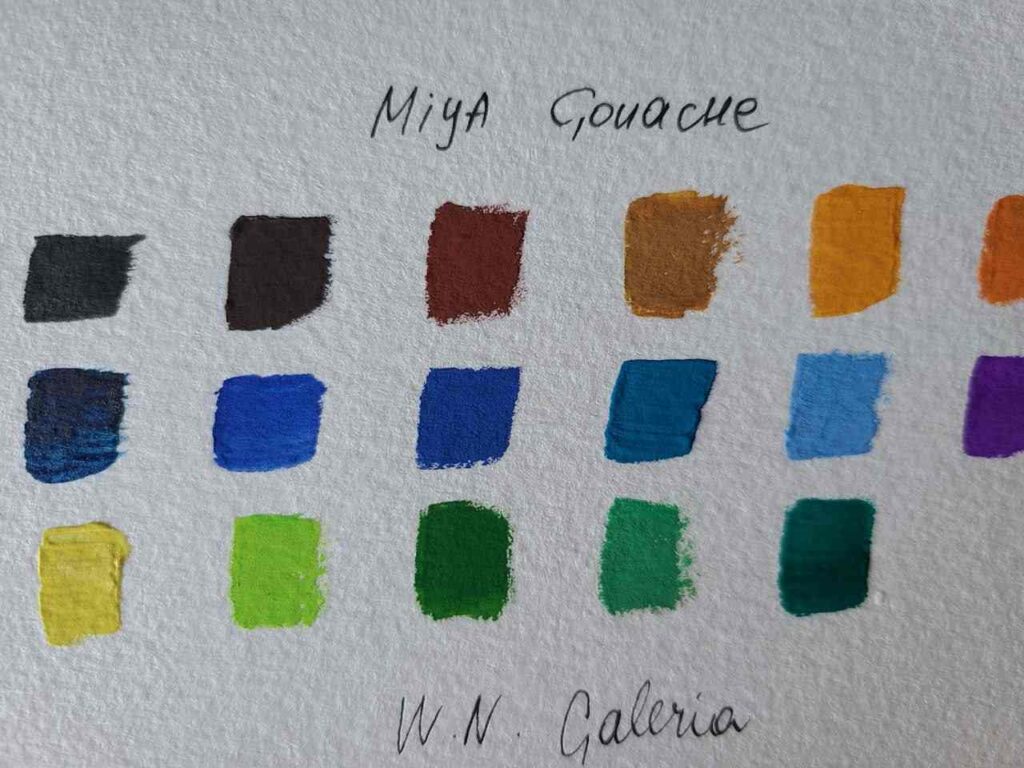
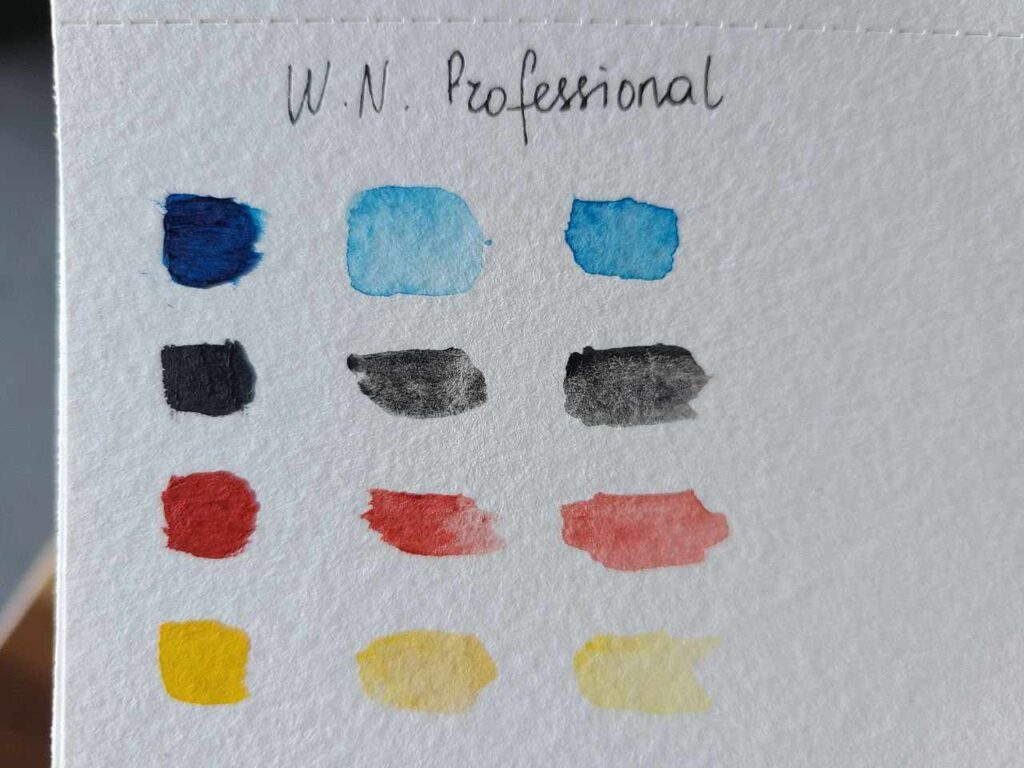
Drying Time
Once you start using acrylic paint, you’ll notice that it dries faster than gouache, making it more challenging to blend. You can, however, extend the drying time by using a retarder or spraying it with water.
Gouache also dries faster than watercolor. However, the difference is that it may be reactivated with water, making it less difficult to blend than acrylic paint.
Related: How Long Does Acrylic Paint Take to Dry? 30 Brands Drying Time
Rewet and Rework
You have learned that gouache and watercolors can be reworked and reactivated using water, but how about acrylics? Unfortunately, acrylics are permanent, which means that you can no longer alter or modify them once they’ve dried.
Surfaces to Paint On
Gouache paint is best used for papers, considering that you only apply a thin layer to keep it from crumbling. On the other hand, acrylic paint is allowed on various surfaces, including canvas, glass, paper, wood, plastic, and more.
Binders
Acrylic and gouache are produced with different types of binders. The binder is the substance that keeps the pigments together and lets them adhere to mediums. Gum Arabic is used as a binder in gouache and watercolor paints. On the other hand, acrylic paints are bound with acrylic polymer emulsion.
Durability
Acrylic paint is generally more durable than gouache. It is also resistant to dust and water. Its durability is due to the acrylic polymer emulsion that serves as its binder.
On the other hand, Gouache paint appears to be less lasting because it is not dust resistant and can be reactivated with water. That’s why if you want to hang your gouache painting on the wall, make sure it’s varnished or in a glassed frame to protect it from dust or water droplets.
Color Vibrancy
Acrylic paintings, as you will notice, have more rich colors than paintings created with other mediums. This is because acrylic paint produces more bright and vibrant hues than gouache and watercolors. As a result, watercolor and gouache paintings seem less vivid when compared.
Find your best gouache among these 15 Best Gouache Paint Sets in 2022 For Beginners and Pros
Acrylic Paint
Acrylic paint is held together by an acrylic polymer (plastic) binder that makes it extra durable. It has a higher level of color vibrancy than gouache paint.
While acrylic paint is also water-based, its colors are lightfast, making it resistant to fading. It is also dust and water-resistant, which means that dust and water will not ruin the pigments.
Pros
- Fast-drying compared to gouache and watercolor
- Less expensive than other paint counterparts
- Has less possibility to crack
- Produces vibrant colors
- You can thin the paint with water
- Can be easily wiped off when wet
- More permanent than gouache and watercolor
- Various application surfaces
Cons
- Cannot be reworked or reactivated when dry
- Its ability to dry quickly might also be a disadvantage
- Brushes used may be susceptible to damage
- When the paint has dried, the layers have a glossy, plastic texture
- Permanent and insoluble when dry
- Saturation decreases over time
Find your best acrylic paint among my favorite Best Acrylic Paint: 20+ Brands Reviewed for Beginners [From Cheap to Pro]
FAQ
What happens if you mix gouache and watercolor?
Considering that gouache and watercolors are almost the same, they can be mixed together. Mixing gouache and watercolor adds new dimensions to the painting. This can add extra colors and textures to your artwork. Even though both mediums use a Gum Arabic binder, gouache still has more pigment than when you use only watercolor.
These two mediums work well together to create great, smooth color. However, the pigments in the gouache will gradually settle to the bottom of the mixture. That’s why it’s important to keep stirring it to keep the colors uniformly dispersed. The result will be slightly more opaque rather than transparent.
How do you turn watercolor into gouache?
You’ll need marble dust and distilled water to convert your watercolor paints into gouache. Since the Renaissance, marble dust has been used as paint filler. It’s a low-cost substance that can transform your transparent watercolor into an opaque gouache paint. Here are a few simple ways to produce the opacity of gouache:
- Fill a bowl with 1/4 teaspoon of marble dust.
- Put 1 1/2 teaspoon of watercolor paint onto the bowl with marble dust, then mix thoroughly. The ratio of watercolor to marble dust would be 6:1.
- Using eye droppers available in your home, squeeze a few drops of distilled water into the mixture, just enough to achieve the appropriate consistency.
- Pour the mixture into your palette once it has reached your desired consistency. Now you’ve turned your watercolor into gouache paint!
Does gouache dry faster than watercolor?
Yes, gouache dries more quickly than watercolor, but it dries a different color than when wet. When the gouache has dried, it will have a flat, matte finish. You can confidently rely on gouache paint if you’re short on time and need quick-drying paint.
To Sum Up
Watercolor and gouache have many differences, but they also share certain similarities, such as the fact that they are both water-soluble. Since they are almost similar, gouache is sometimes referred to as “opaque watercolor.” However, remember that gouache dries faster than watercolor, making it a favorite of amateur and professional painters.
There are several factors to consider when choosing the best paint for you. If you haven’t decided between gouache and watercolor yet, you may review this article to guide you in selecting the best paint that suits your painting needs.

Masha Eretnova, born in 1991, is a Buenos Aires-based certified teacher, artist, and member of the Professional Artist Association with 20+ years of personal painting journey.
She started painting and drawing very early and is now an international abstract artist and educator passionate about acrylic painting, gouache, and crafts.
Her works are part of international exhibitions and contests, including ArtlyMix (Brazil), Al-Tiba 9 (Spain), Exhibizone (Canada), Italy, and many more.
Besides her artistic pursuits, Masha holds a post-grad diploma in Teaching Film Photography and 2 music school diplomas: piano and opera singing.
Last update on 2024-07-26 / Affiliate links / Images from Amazon Product Advertising API
